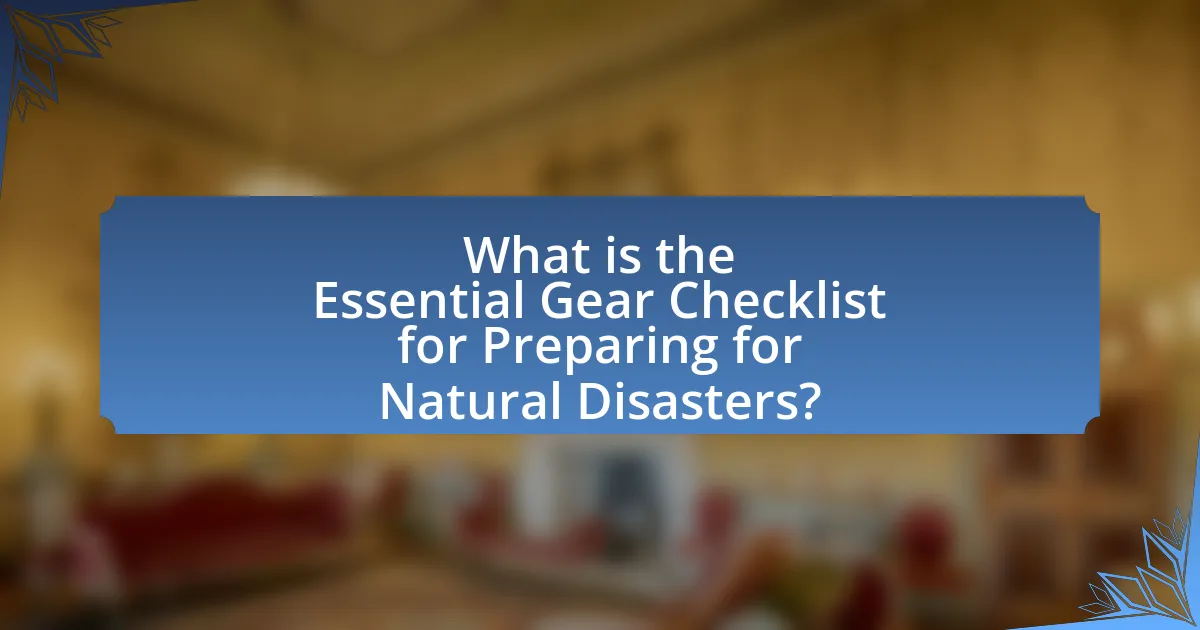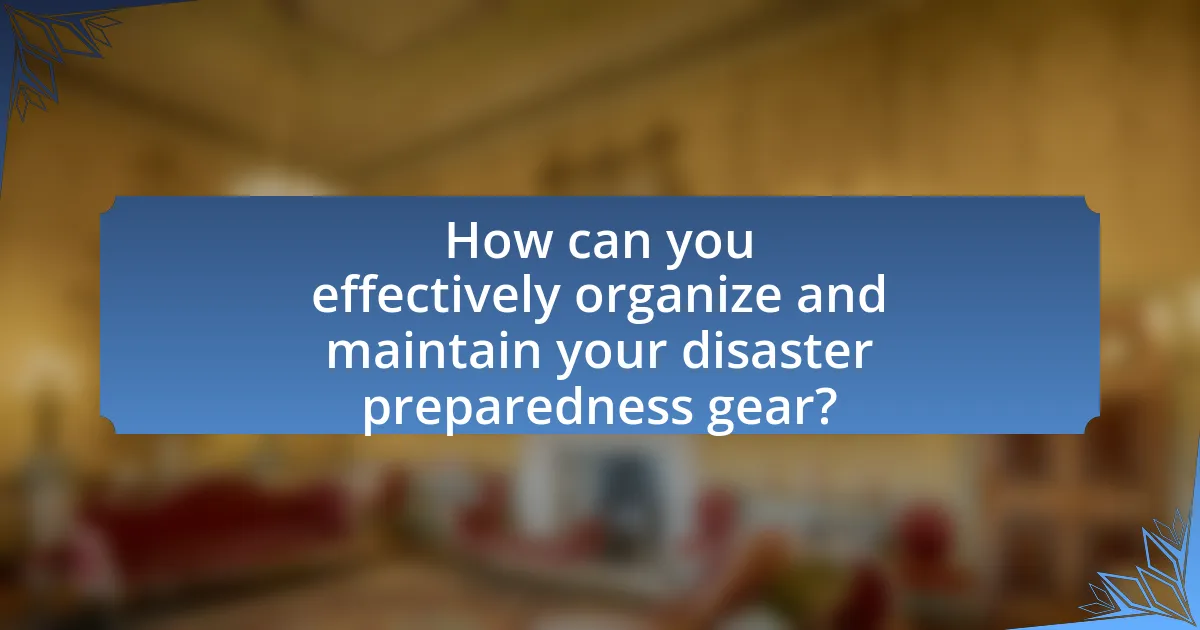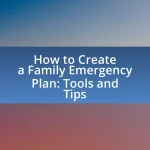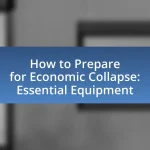The article focuses on the essential gear checklist for preparing for natural disasters, emphasizing the importance of having necessary supplies to ensure safety, sustenance, and communication during emergencies. Key items include a first aid kit, non-perishable food, bottled water, and a flashlight, among others, as recommended by the Federal Emergency Management Agency (FEMA). It discusses the significance of preparedness, the potential consequences of being unprepared, and how a well-structured checklist can enhance readiness for various types of natural disasters, such as hurricanes, earthquakes, and floods. Additionally, the article outlines strategies for organizing and maintaining disaster preparedness gear, common mistakes to avoid, and resources available for further guidance on disaster preparedness.

What is the Essential Gear Checklist for Preparing for Natural Disasters?
The essential gear checklist for preparing for natural disasters includes items that ensure safety, sustenance, and communication. Key items are a first aid kit, non-perishable food, bottled water, a flashlight with extra batteries, a multi-tool, a battery-powered or hand-crank radio, personal documents, and a whistle. According to the Federal Emergency Management Agency (FEMA), having these supplies can significantly increase survival chances during emergencies, as they provide necessary resources for health, safety, and information access.
Why is having an essential gear checklist important for disaster preparedness?
Having an essential gear checklist is crucial for disaster preparedness because it ensures individuals are equipped with necessary supplies during emergencies. A well-structured checklist helps to systematically identify and gather items such as food, water, medical supplies, and tools, which are vital for survival in crisis situations. Research indicates that preparedness can significantly reduce the impact of disasters; for instance, the Federal Emergency Management Agency (FEMA) states that having a plan and the right supplies can increase the likelihood of survival and recovery. Thus, an essential gear checklist serves as a practical guide to enhance readiness and mitigate risks associated with natural disasters.
What are the potential consequences of not being prepared?
Not being prepared for natural disasters can lead to severe consequences, including loss of life, injury, and significant property damage. Historical data shows that during Hurricane Katrina in 2005, inadequate preparedness resulted in over 1,800 fatalities and billions in damages, highlighting the critical need for readiness. Additionally, unprepared individuals may face prolonged recovery times, increased stress, and financial burdens due to unexpected expenses related to disaster response and recovery efforts.
How can a checklist improve your readiness for emergencies?
A checklist can significantly improve your readiness for emergencies by ensuring that all necessary items and actions are accounted for in advance. By systematically listing essential gear and tasks, individuals can minimize the risk of forgetting critical supplies, which is crucial during high-stress situations like natural disasters. Research indicates that preparedness checklists enhance response efficiency; for example, a study published in the Journal of Emergency Management found that individuals who used checklists were 30% more likely to have essential supplies ready compared to those who did not. This structured approach not only fosters confidence but also facilitates quicker decision-making when time is of the essence.
What types of natural disasters should you prepare for?
You should prepare for earthquakes, hurricanes, floods, tornadoes, wildfires, and winter storms. Each of these natural disasters poses significant risks to life and property. For instance, the United States experiences approximately 1,000 to 2,000 earthquakes annually, with the potential for severe damage in affected areas. Hurricanes can lead to catastrophic flooding, as seen with Hurricane Katrina in 2005, which caused over $125 billion in damages. Flooding is the most common and widespread natural disaster, affecting millions each year. Tornadoes, particularly in Tornado Alley, can produce winds exceeding 300 mph, resulting in extensive destruction. Wildfires, especially in regions like California, have increased in frequency and intensity, threatening homes and ecosystems. Lastly, winter storms can disrupt transportation and utilities, leading to dangerous conditions. Preparing for these disasters involves having an emergency kit, a communication plan, and knowledge of local evacuation routes.
How do different disasters affect the type of gear needed?
Different disasters necessitate specific types of gear tailored to their unique challenges. For instance, in the case of hurricanes, gear such as waterproof tarps, life jackets, and portable generators are essential due to flooding and power outages. Conversely, for wildfires, protective clothing, fire-resistant gear, and air filtration masks are critical to safeguard against smoke and heat. Earthquakes require sturdy footwear, emergency food supplies, and first aid kits to address injuries and ensure mobility in debris-laden environments. Each disaster type dictates the gear needed based on the specific hazards it presents, ensuring preparedness and safety.
What are the most common natural disasters to consider?
The most common natural disasters to consider include hurricanes, earthquakes, floods, tornadoes, wildfires, and tsunamis. These events frequently occur worldwide, with hurricanes causing significant damage in coastal areas, earthquakes affecting regions along tectonic plate boundaries, and floods resulting from heavy rainfall or storm surges. For instance, the National Oceanic and Atmospheric Administration (NOAA) reports that hurricanes have caused billions in damages annually in the United States alone. Earthquakes, such as the 2010 Haiti earthquake, resulted in over 200,000 fatalities and widespread destruction. Flooding is the most common and widespread natural disaster, impacting millions globally each year. Tornadoes, particularly in the United States, occur frequently and can cause severe localized damage. Wildfires, exacerbated by climate change, have become increasingly common in regions like California. Tsunamis, while less frequent, can have devastating effects, as seen in the 2004 Indian Ocean tsunami, which resulted in over 230,000 deaths across multiple countries.

What items should be included in your essential gear checklist?
An essential gear checklist for preparing for natural disasters should include a first aid kit, non-perishable food, water, a flashlight, batteries, a multi-tool, a whistle, a portable phone charger, and important documents. These items are critical for survival and safety during emergencies. For instance, the American Red Cross recommends having at least a three-day supply of food and water for each person in your household, highlighting the importance of preparedness in disaster situations.
What are the basic supplies everyone should have?
Basic supplies everyone should have include water, non-perishable food, a flashlight, batteries, a first aid kit, and a multi-tool. These items are essential for survival during natural disasters, as they provide hydration, nutrition, illumination, medical assistance, and versatile tools for various situations. According to the Federal Emergency Management Agency (FEMA), having at least one gallon of water per person per day for three days and a three-day supply of food is crucial for emergency preparedness.
How much water and food should you store?
Store at least one gallon of water per person per day for a minimum of three days, totaling 12 gallons for a family of four. Additionally, store a minimum of a three-day supply of non-perishable food per person, which equates to approximately 9 meals per person. This recommendation is based on guidelines from the Federal Emergency Management Agency (FEMA), which emphasizes the importance of having adequate supplies to sustain individuals during emergencies.
What first aid supplies are essential for your kit?
Essential first aid supplies for your kit include adhesive bandages, sterile gauze pads, antiseptic wipes, adhesive tape, scissors, tweezers, a digital thermometer, and a CPR face shield. These items are crucial for treating minor injuries, preventing infection, and providing emergency care. The American Red Cross recommends having these supplies readily available to ensure preparedness for injuries that may occur during natural disasters.
What specialized gear might be necessary for specific disasters?
Specialized gear necessary for specific disasters includes items tailored to the nature of the disaster. For hurricanes, waterproof tarps and high-quality flashlights are essential for protection and visibility. In earthquakes, sturdy helmets and knee pads can prevent injuries during aftershocks. Floods require inflatable boats and life vests for safe evacuation. Wildfires necessitate fire-resistant clothing and respirators to protect against smoke inhalation. Each type of disaster demands specific gear to ensure safety and effective response, as evidenced by emergency preparedness guidelines from organizations like FEMA, which emphasize the importance of tailored equipment for various disaster scenarios.
What tools are important for hurricanes and floods?
Important tools for hurricanes and floods include weather radios, emergency kits, sandbags, and portable generators. Weather radios provide real-time updates on storm conditions, which is crucial for safety. Emergency kits should contain food, water, first aid supplies, and flashlights to sustain individuals during power outages or evacuations. Sandbags are effective for redirecting floodwaters and protecting property. Portable generators supply electricity when the power grid fails, ensuring essential appliances remain operational. These tools are vital for preparedness and response during such natural disasters.
How can you prepare for earthquakes with specific gear?
To prepare for earthquakes with specific gear, individuals should assemble an emergency kit that includes essential items such as water, non-perishable food, a flashlight, batteries, a first aid kit, and a whistle. These items are crucial for survival during and after an earthquake, as they provide necessary sustenance and aid in communication. According to the Federal Emergency Management Agency (FEMA), having at least a three-day supply of food and water is recommended for emergency preparedness. Additionally, sturdy footwear and a multi-tool can be beneficial for navigating debris and performing basic repairs.

How can you effectively organize and maintain your disaster preparedness gear?
To effectively organize and maintain your disaster preparedness gear, categorize items by type and purpose, ensuring easy access during emergencies. For instance, group supplies such as food, water, first aid kits, and tools separately in clearly labeled containers or bags. Regularly check expiration dates on food and medical supplies, replacing items as needed to ensure readiness. According to the Federal Emergency Management Agency (FEMA), maintaining an updated inventory of your gear and practicing emergency drills can significantly enhance preparedness, as it familiarizes all household members with the location and use of the gear.
What strategies can help you keep your gear accessible and ready?
To keep your gear accessible and ready, organize it in a designated, easily reachable location. This strategy ensures that all essential items are stored together, minimizing the time needed to gather them during an emergency. For instance, using clear bins or labeled bags can help identify contents quickly, which is crucial during high-stress situations like natural disasters. Additionally, regularly checking and updating your gear ensures that items remain functional and relevant, as statistics show that preparedness can significantly reduce response time and improve safety outcomes during emergencies.
How often should you check and update your supplies?
You should check and update your supplies at least once every six months. Regularly assessing your supplies ensures that items are not expired, damaged, or depleted, which is crucial for effective preparedness during natural disasters. According to the Federal Emergency Management Agency (FEMA), maintaining an updated emergency kit can significantly enhance your readiness and response capabilities in crisis situations.
What storage solutions work best for emergency gear?
The best storage solutions for emergency gear include waterproof bins, durable backpacks, and designated emergency cabinets. Waterproof bins protect gear from moisture and environmental damage, making them ideal for storing items like first aid kits, food supplies, and tools. Durable backpacks facilitate easy transport of essential gear during evacuations, ensuring that critical items are readily accessible. Designated emergency cabinets provide organized storage for larger supplies, such as flashlights, batteries, and blankets, allowing for quick retrieval in urgent situations. These solutions enhance preparedness by ensuring that emergency gear is safe, organized, and easily accessible when needed.
What are some common mistakes to avoid when preparing for natural disasters?
Common mistakes to avoid when preparing for natural disasters include failing to create an emergency plan, neglecting to assemble a comprehensive emergency kit, and underestimating the time needed for preparation. Many individuals do not discuss evacuation routes or communication strategies with family members, which can lead to confusion during a crisis. Additionally, emergency kits often lack essential items such as water, non-perishable food, first aid supplies, and necessary medications, which can hinder survival. Research indicates that 60% of Americans do not have an emergency plan, highlighting the importance of proactive preparation. Lastly, waiting until a disaster is imminent to gather supplies can result in shortages and increased panic, making it crucial to prepare well in advance.
How can overpacking or underpacking affect your preparedness?
Overpacking can hinder your preparedness by causing unnecessary weight and bulk, making it difficult to transport essential items quickly during a natural disaster. Conversely, underpacking can leave you without critical supplies, such as food, water, or medical kits, which are vital for survival in emergency situations. Research indicates that individuals who are well-prepared with the right amount of supplies are more likely to respond effectively to disasters, as highlighted in the FEMA guidelines on emergency preparedness.
What misconceptions about disaster gear should you be aware of?
One misconception about disaster gear is that it is only necessary for extreme weather events, while in reality, preparedness is essential for a wide range of emergencies, including minor incidents. Many individuals believe that having a few basic items, such as water and flashlights, is sufficient; however, comprehensive disaster kits should include food, first aid supplies, tools, and sanitation items to effectively address various scenarios. Research from the Federal Emergency Management Agency (FEMA) indicates that 60% of Americans do not have an emergency kit, highlighting the gap in preparedness and the importance of understanding the full scope of necessary gear.
What practical tips can enhance your disaster preparedness efforts?
To enhance disaster preparedness efforts, individuals should create a comprehensive emergency plan that includes communication strategies, evacuation routes, and designated meeting points. Research indicates that having a written plan increases the likelihood of effective response during emergencies, as noted in a study by the Federal Emergency Management Agency (FEMA), which found that families with preparedness plans are 50% more likely to respond effectively in a disaster. Additionally, assembling an emergency kit with essential supplies such as water, non-perishable food, first aid items, and flashlights is crucial, as the American Red Cross recommends having at least a three-day supply of these items readily available. Regularly reviewing and practicing the plan ensures that all family members are familiar with their roles, further improving readiness.
How can you involve your family in the preparation process?
Involving your family in the preparation process for natural disasters can be achieved by assigning specific roles and tasks to each member. For example, adults can be responsible for gathering essential supplies, while children can help organize items or create emergency contact lists. This collaborative approach not only ensures that everyone contributes but also fosters a sense of responsibility and awareness about disaster preparedness. Research indicates that family involvement in emergency planning increases the likelihood of effective response during actual events, as families who prepare together are more likely to have a clear understanding of their roles and the necessary actions to take.
What resources are available for further guidance on disaster preparedness?
The resources available for further guidance on disaster preparedness include the Federal Emergency Management Agency (FEMA), the American Red Cross, and the Centers for Disease Control and Prevention (CDC). FEMA provides comprehensive information on emergency planning, response, and recovery, including downloadable guides and checklists. The American Red Cross offers resources such as preparedness courses, emergency kits, and community training programs. The CDC focuses on public health preparedness, providing guidelines on how to prepare for various types of disasters, including natural disasters. These organizations are recognized authorities in disaster preparedness, ensuring that the information they provide is reliable and actionable.


